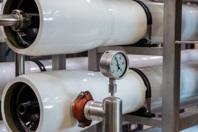DESALINATION RESOURCES
-
Researchers have developed polyimide-based membranes for membrane distillation (MD) that overcome three persistent issues in membranes for water treatment and gas separations: the need for pore-forming chemicals that prevent recycling, performance degradation due to pore wetting and fouling, and the inherent trade-off between high water flux and selectivity.
-
Small municipalities and industrial sites face constant pressure: deliver safe, stable water with limited resources and tight deadlines. Traditional on-site construction can stretch project schedules by months and introduce quality and cost risks. By shifting much of the fabrication off-site, these risks are dramatically reduced.
-
How Edison vs. Tesla shapes today's approach to sustainable water systems.
-
Researchers warn that California and other states affected by megadroughts — periods of drought lasting 20+ years — will have to accept this as the new normal. That means rethinking the water cycle and finding new, more sustainable water sources.
-
This article explores how IDE Technologies leveraged advanced in-house simulation capabilities to deliver a revised brine diffuser design, significantly improving both environmental outcomes and operational efficiency.
-
Read about a seawater desalination plant that presented with several performance issues and chose the HOD UV system to control biofouling on the RO membranes.
-
As water-scarce regions clamor for answers, developments in membrane anti-scaling bring desalination closer to viability.
-
Leaning on a wealth of experience, an engineer lays the groundwork for successful, cost-effective desalination projects.
-
Environmental, social, and governance (ESG) policy can yield a powerful outcome when integrated into a corporate strategy. Though strategizing and rolling out this assessment can be time- and resource-intensive, when done correctly, companies will realize several benefits in the short and long term.
-
One of the globe's major problems is the lack of water, but due to the growing demand for water in the fields of agriculture and industry, as well as a population shift to cities, efficient water use is made more urgent. The good news is that there are newly implemented technologies that deal with the issue of water conservation and management.










